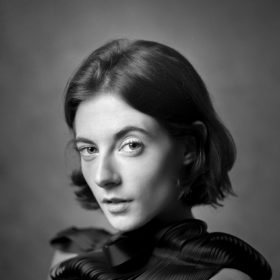May 11, 2022 at 07:28PM
Bri Scalesse’s favourite part of modelling is the runway — the chaotic energy backstage, the palpable excitement beaming off the audience and the adrenalin that comes from using her body to make a piece of art come to life. “It’s such a shift in the way that I experience people’s eyes being on me,” she says. “As a person with a disability, I’m used to being stared at as I go down the street or live my life in general. But when I’m on the runway, I feel really powerful. I feel present in my body.”
The 27-year-old’s dream to be a model began after she became a wheelchair user at age six due to a car accident that left her legs paralyzed. She recalls flipping through pages of magazines and seeing articles titled “How to Dress for Your Body Type” that were accompanied by photos of women who were tall, short or petite but none of the models were disabled. “There was no body that looked like mine,” she says. “I realized there was this hole that made me feel like I didn’t know where I fit.” Up until she saw disabled actor and model Jillian Mercado featured in a 2014 clothing campaign, Scalesse hadn’t considered modelling to be a real possibility.
“I grew up feeling like my body wasn’t desirable, so I wanted to change that for myself but also for other people in chairs,” she explains. In 2019, two years after moving from Connecticut to New York City, she landed her first job in a campaign for Ffora, a wheelchair accessories brand. It was “a dream situation,” she says, as everyone on-set understood the importance of accessibility. Since then, Scalesse has wheeled in New York Bridal Fashion Week and on Project Runway and has appeared in global campaigns for brands like Nars and Ugg.

As her modelling career has grown, so, too, has her social media presence. Scalesse has cultivated nearly a half a million followers on TikTok, where she posts snippets of her life, promotes her work and raises awareness about issues affecting her community — including representation in the fashion industry. In one viral video, she starts by listing discouraging comments directed toward disabled aspiring models and follows them up with a slide of photos from her many campaigns, captioning it “Never say never.”
“Only now are we seeing people with visible disabilities start to be included in the body-positivity movement,” she says, noting that brands often feature disabled models for one-off campaigns or brief moments. “I think equality will come when we see disabled models alongside models of all different body types all the time. I want more for my community.”
Since she started modelling, Scalesse has experienced firsthand the ableism that exists within the industry. One of her very first gigs was held at a venue that was inaccessible. The models’ designated dressing room was located down a flight of stairs, with no way for her to descend safely. The only wheelchair-friendly spaces for her to get ready in were the main-floor bathroom and kitchen, where she was completely removed from the other models. “I felt like I just didn’t have a place, quite literally,” she says.
Back then, Scalesse often suffered silently when faced with ableist working conditions. Now, she always speaks up for herself. But she shouldn’t have to. “I don’t think it should be on the model to have to fight so hard to exist somewhere in the same space as other models,” she says. “Accessibility should be the standard, not an exception.”
View this post on Instagram
The model’s bond with her wheelchair is one of pure love and intimacy. Years ago, she named her chair Aphrodite, or Aph for short, to symbolize that it’s a part of her, not just a tool she uses. But this past summer, that part was taken away when her chair was broken during a plane ride. “I knew I had a connection to Aphrodite, but when she was broken beyond repair, I realized how deep that connection was,” she recounts. “It was like this loss of my body — and a loss of me in many ways.” Having wheelchairs broken by airlines is a common experience for the disabled community, says Scalesse, and it can be life altering. “At that moment, I was like: ‘How am I going to model? How am I going to go to work? How am I going to live my life?’” It took about six weeks for her to get used to her new custom chair. She named it Onyx, inspired by Greek mythology (just like Aphrodite). Scalesse cites a creation myth in which the ancient goddess Aphrodite’s nails are cut and transformed into the onyx stone. “It really resonated with me, because Onyx was kind of birthed from Aph.”
In addition to modelling, Scalesse has a passion for storytelling. In 2020, she earned a master’s degree in non-fiction writing from Columbia University. For her thesis, she began working on a memoir that she hopes to one day see published. “I want to show the immense intricacies of being a disabled woman in the world,” she says. “I just want people to see the nitty-gritty of it, because I think sharing my story will help further my message about my community.” For her, modelling and advocacy will always be intertwined. “I’m going to continue to push for representation for the rest of my life,” she says. “I want to be in castings, in rooms and on runways with other people in chairs. I don’t want to be the only one at the table.”
This article first appeared in FASHION’s May issue. Find out more here.
The post Bri Scalesse Wants to See More Disabled Models appeared first on FASHION Magazine.
Read More Fashion News
Author Natalie Michie | Fashion Magazine
Selected by CWC



